Clinical Management Plan: A Comprehensive Speech Disorder Analysis
VerifiedAdded on 2021/11/05
|13
|3962
|57
Report
AI Summary
This clinical management plan addresses speech and language disorders, focusing on a patient named Paul who experienced ear infections leading to slow literary skills and language development. The report summarizes Paul's information, highlighting receptive, expressive, and cognitive difficulties, and provides a theoretical rationale for his condition. It outlines treatment goals aimed at rectifying receptive, expressive, cognitive, fluency, and vocabulary challenges, and proposes therapy programs including educational, family, communication, and behavior therapies. The plan reviews the efficacy of these programs, suggests methods for measuring and analyzing interventions, and details interventional activities towards recovery. The report emphasizes the importance of tailored approaches, such as articulation and Lovaas programs, and the involvement of teachers, parents, and specialists to improve the patient's communication and social skills. It also stresses the need for considering potential medication side effects and the use of non-medication remedies. The report concludes by describing methods for measuring the effectiveness of the therapies through observation of pronunciation, spelling, social interaction, and narrative retelling.
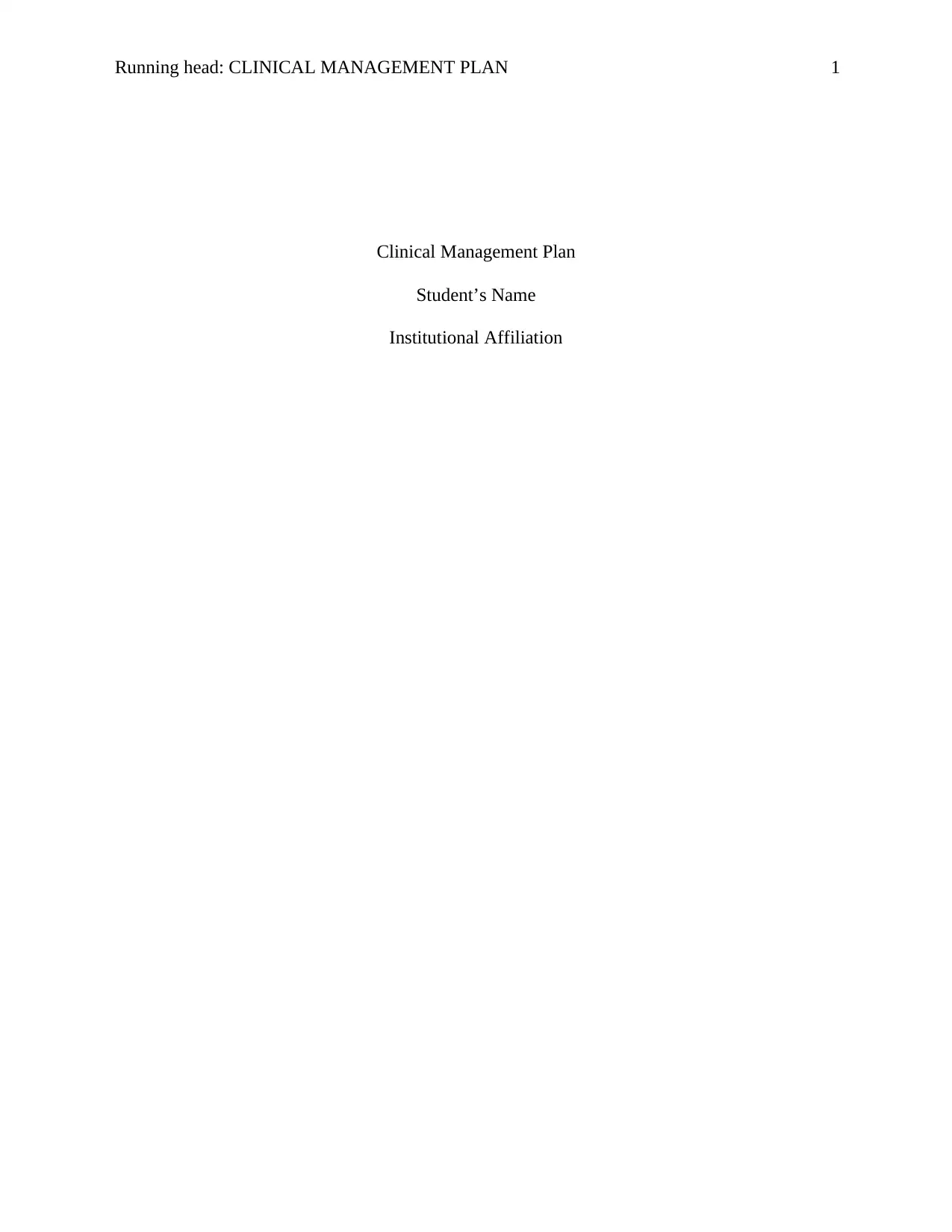
Running head: CLINICAL MANAGEMENT PLAN 1
Clinical Management Plan
Student’s Name
Institutional Affiliation
Clinical Management Plan
Student’s Name
Institutional Affiliation
Paraphrase This Document
Need a fresh take? Get an instant paraphrase of this document with our AI Paraphraser
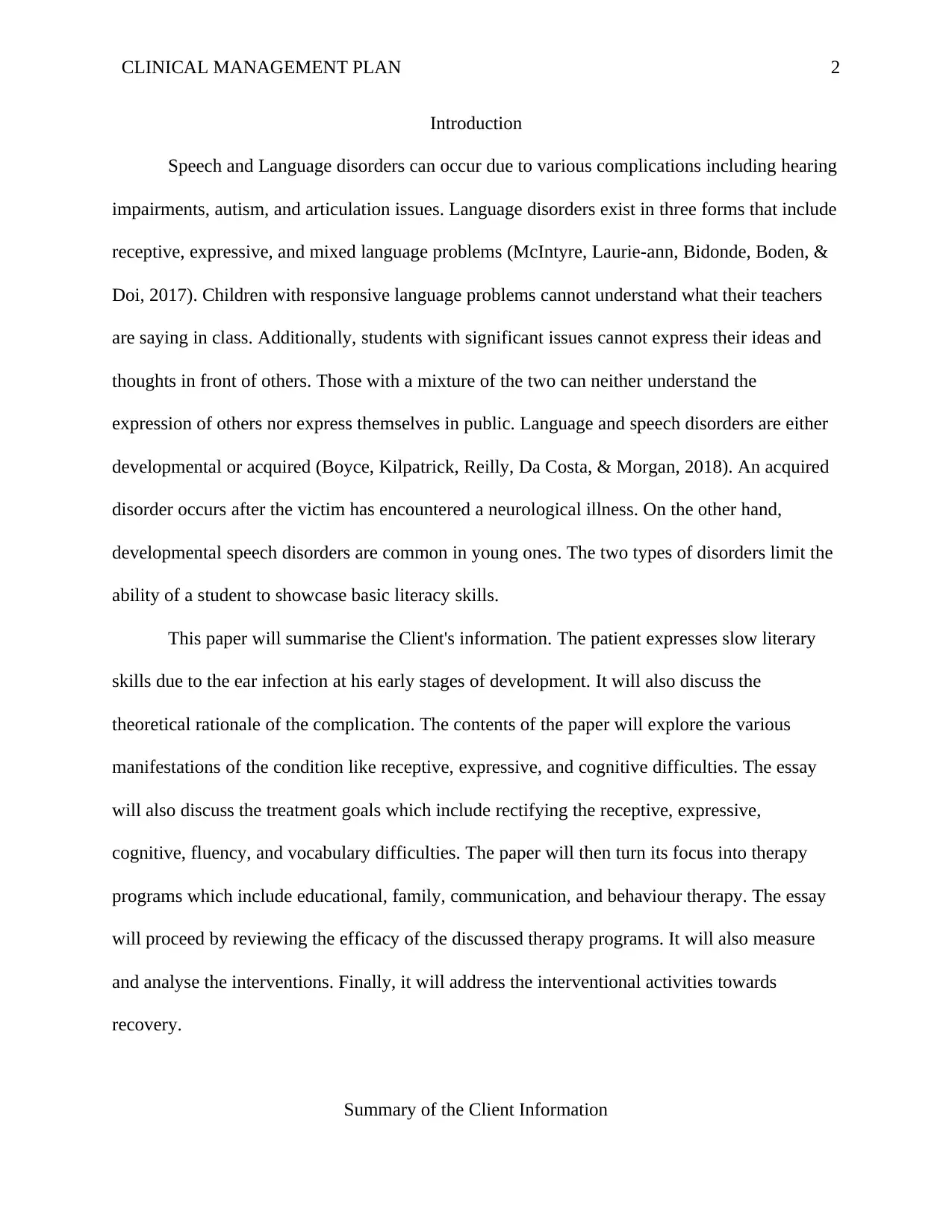
CLINICAL MANAGEMENT PLAN 2
Introduction
Speech and Language disorders can occur due to various complications including hearing
impairments, autism, and articulation issues. Language disorders exist in three forms that include
receptive, expressive, and mixed language problems (McIntyre, Laurie-ann, Bidonde, Boden, &
Doi, 2017). Children with responsive language problems cannot understand what their teachers
are saying in class. Additionally, students with significant issues cannot express their ideas and
thoughts in front of others. Those with a mixture of the two can neither understand the
expression of others nor express themselves in public. Language and speech disorders are either
developmental or acquired (Boyce, Kilpatrick, Reilly, Da Costa, & Morgan, 2018). An acquired
disorder occurs after the victim has encountered a neurological illness. On the other hand,
developmental speech disorders are common in young ones. The two types of disorders limit the
ability of a student to showcase basic literacy skills.
This paper will summarise the Client's information. The patient expresses slow literary
skills due to the ear infection at his early stages of development. It will also discuss the
theoretical rationale of the complication. The contents of the paper will explore the various
manifestations of the condition like receptive, expressive, and cognitive difficulties. The essay
will also discuss the treatment goals which include rectifying the receptive, expressive,
cognitive, fluency, and vocabulary difficulties. The paper will then turn its focus into therapy
programs which include educational, family, communication, and behaviour therapy. The essay
will proceed by reviewing the efficacy of the discussed therapy programs. It will also measure
and analyse the interventions. Finally, it will address the interventional activities towards
recovery.
Summary of the Client Information
Introduction
Speech and Language disorders can occur due to various complications including hearing
impairments, autism, and articulation issues. Language disorders exist in three forms that include
receptive, expressive, and mixed language problems (McIntyre, Laurie-ann, Bidonde, Boden, &
Doi, 2017). Children with responsive language problems cannot understand what their teachers
are saying in class. Additionally, students with significant issues cannot express their ideas and
thoughts in front of others. Those with a mixture of the two can neither understand the
expression of others nor express themselves in public. Language and speech disorders are either
developmental or acquired (Boyce, Kilpatrick, Reilly, Da Costa, & Morgan, 2018). An acquired
disorder occurs after the victim has encountered a neurological illness. On the other hand,
developmental speech disorders are common in young ones. The two types of disorders limit the
ability of a student to showcase basic literacy skills.
This paper will summarise the Client's information. The patient expresses slow literary
skills due to the ear infection at his early stages of development. It will also discuss the
theoretical rationale of the complication. The contents of the paper will explore the various
manifestations of the condition like receptive, expressive, and cognitive difficulties. The essay
will also discuss the treatment goals which include rectifying the receptive, expressive,
cognitive, fluency, and vocabulary difficulties. The paper will then turn its focus into therapy
programs which include educational, family, communication, and behaviour therapy. The essay
will proceed by reviewing the efficacy of the discussed therapy programs. It will also measure
and analyse the interventions. Finally, it will address the interventional activities towards
recovery.
Summary of the Client Information
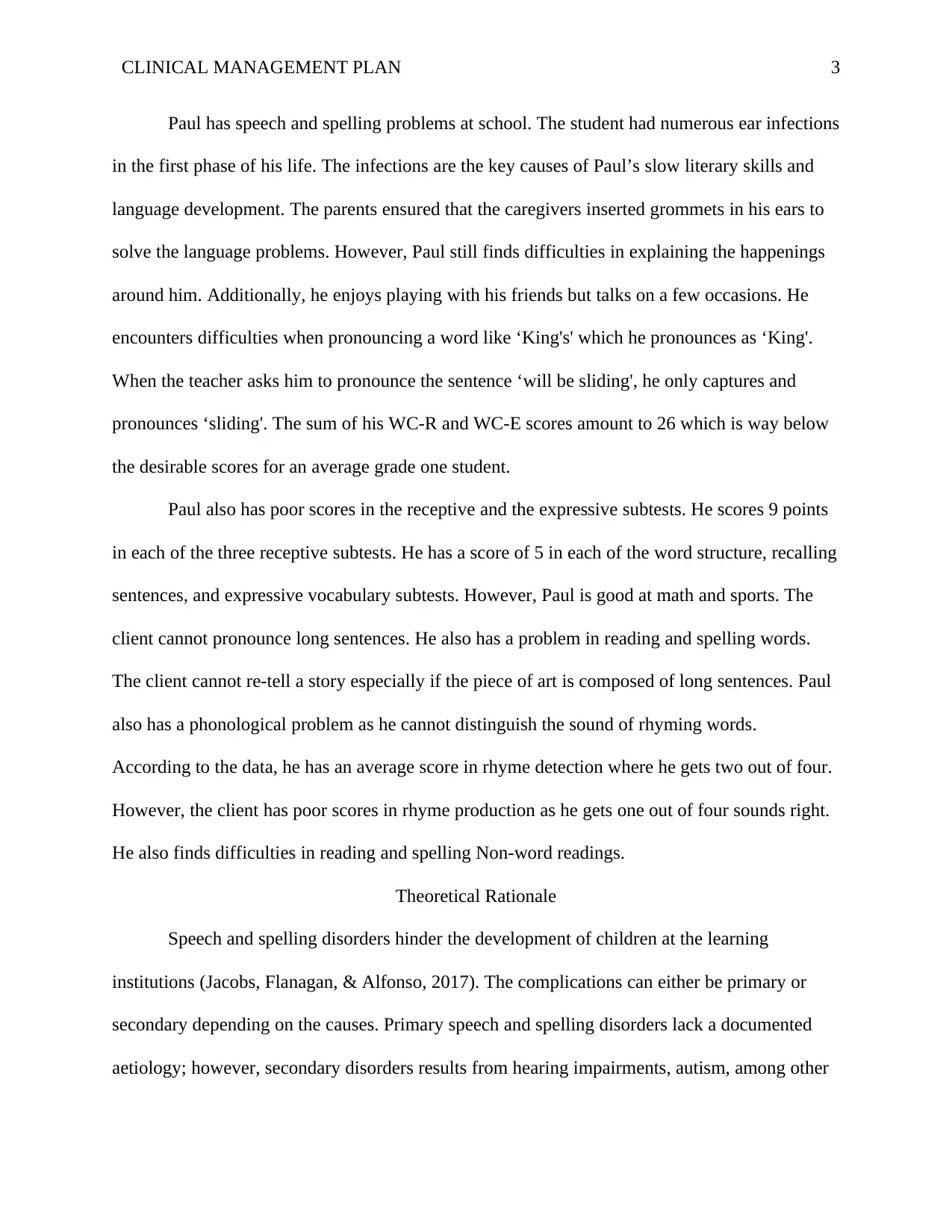
CLINICAL MANAGEMENT PLAN 3
Paul has speech and spelling problems at school. The student had numerous ear infections
in the first phase of his life. The infections are the key causes of Paul’s slow literary skills and
language development. The parents ensured that the caregivers inserted grommets in his ears to
solve the language problems. However, Paul still finds difficulties in explaining the happenings
around him. Additionally, he enjoys playing with his friends but talks on a few occasions. He
encounters difficulties when pronouncing a word like ‘King's' which he pronounces as ‘King'.
When the teacher asks him to pronounce the sentence ‘will be sliding', he only captures and
pronounces ‘sliding'. The sum of his WC-R and WC-E scores amount to 26 which is way below
the desirable scores for an average grade one student.
Paul also has poor scores in the receptive and the expressive subtests. He scores 9 points
in each of the three receptive subtests. He has a score of 5 in each of the word structure, recalling
sentences, and expressive vocabulary subtests. However, Paul is good at math and sports. The
client cannot pronounce long sentences. He also has a problem in reading and spelling words.
The client cannot re-tell a story especially if the piece of art is composed of long sentences. Paul
also has a phonological problem as he cannot distinguish the sound of rhyming words.
According to the data, he has an average score in rhyme detection where he gets two out of four.
However, the client has poor scores in rhyme production as he gets one out of four sounds right.
He also finds difficulties in reading and spelling Non-word readings.
Theoretical Rationale
Speech and spelling disorders hinder the development of children at the learning
institutions (Jacobs, Flanagan, & Alfonso, 2017). The complications can either be primary or
secondary depending on the causes. Primary speech and spelling disorders lack a documented
aetiology; however, secondary disorders results from hearing impairments, autism, among other
Paul has speech and spelling problems at school. The student had numerous ear infections
in the first phase of his life. The infections are the key causes of Paul’s slow literary skills and
language development. The parents ensured that the caregivers inserted grommets in his ears to
solve the language problems. However, Paul still finds difficulties in explaining the happenings
around him. Additionally, he enjoys playing with his friends but talks on a few occasions. He
encounters difficulties when pronouncing a word like ‘King's' which he pronounces as ‘King'.
When the teacher asks him to pronounce the sentence ‘will be sliding', he only captures and
pronounces ‘sliding'. The sum of his WC-R and WC-E scores amount to 26 which is way below
the desirable scores for an average grade one student.
Paul also has poor scores in the receptive and the expressive subtests. He scores 9 points
in each of the three receptive subtests. He has a score of 5 in each of the word structure, recalling
sentences, and expressive vocabulary subtests. However, Paul is good at math and sports. The
client cannot pronounce long sentences. He also has a problem in reading and spelling words.
The client cannot re-tell a story especially if the piece of art is composed of long sentences. Paul
also has a phonological problem as he cannot distinguish the sound of rhyming words.
According to the data, he has an average score in rhyme detection where he gets two out of four.
However, the client has poor scores in rhyme production as he gets one out of four sounds right.
He also finds difficulties in reading and spelling Non-word readings.
Theoretical Rationale
Speech and spelling disorders hinder the development of children at the learning
institutions (Jacobs, Flanagan, & Alfonso, 2017). The complications can either be primary or
secondary depending on the causes. Primary speech and spelling disorders lack a documented
aetiology; however, secondary disorders results from hearing impairments, autism, among other
⊘ This is a preview!⊘
Do you want full access?
Subscribe today to unlock all pages.

Trusted by 1+ million students worldwide
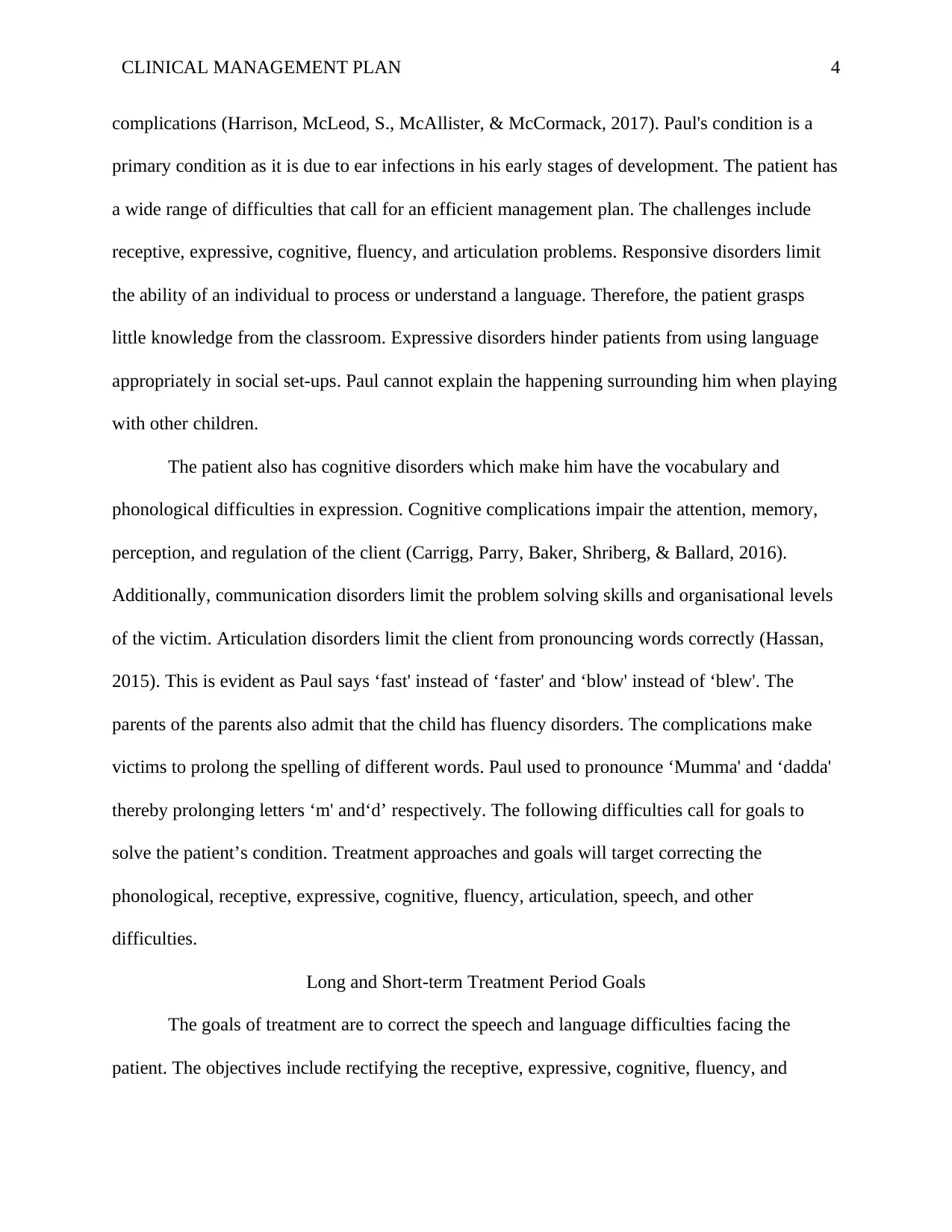
CLINICAL MANAGEMENT PLAN 4
complications (Harrison, McLeod, S., McAllister, & McCormack, 2017). Paul's condition is a
primary condition as it is due to ear infections in his early stages of development. The patient has
a wide range of difficulties that call for an efficient management plan. The challenges include
receptive, expressive, cognitive, fluency, and articulation problems. Responsive disorders limit
the ability of an individual to process or understand a language. Therefore, the patient grasps
little knowledge from the classroom. Expressive disorders hinder patients from using language
appropriately in social set-ups. Paul cannot explain the happening surrounding him when playing
with other children.
The patient also has cognitive disorders which make him have the vocabulary and
phonological difficulties in expression. Cognitive complications impair the attention, memory,
perception, and regulation of the client (Carrigg, Parry, Baker, Shriberg, & Ballard, 2016).
Additionally, communication disorders limit the problem solving skills and organisational levels
of the victim. Articulation disorders limit the client from pronouncing words correctly (Hassan,
2015). This is evident as Paul says ‘fast' instead of ‘faster' and ‘blow' instead of ‘blew'. The
parents of the parents also admit that the child has fluency disorders. The complications make
victims to prolong the spelling of different words. Paul used to pronounce ‘Mumma' and ‘dadda'
thereby prolonging letters ‘m' and‘d’ respectively. The following difficulties call for goals to
solve the patient’s condition. Treatment approaches and goals will target correcting the
phonological, receptive, expressive, cognitive, fluency, articulation, speech, and other
difficulties.
Long and Short-term Treatment Period Goals
The goals of treatment are to correct the speech and language difficulties facing the
patient. The objectives include rectifying the receptive, expressive, cognitive, fluency, and
complications (Harrison, McLeod, S., McAllister, & McCormack, 2017). Paul's condition is a
primary condition as it is due to ear infections in his early stages of development. The patient has
a wide range of difficulties that call for an efficient management plan. The challenges include
receptive, expressive, cognitive, fluency, and articulation problems. Responsive disorders limit
the ability of an individual to process or understand a language. Therefore, the patient grasps
little knowledge from the classroom. Expressive disorders hinder patients from using language
appropriately in social set-ups. Paul cannot explain the happening surrounding him when playing
with other children.
The patient also has cognitive disorders which make him have the vocabulary and
phonological difficulties in expression. Cognitive complications impair the attention, memory,
perception, and regulation of the client (Carrigg, Parry, Baker, Shriberg, & Ballard, 2016).
Additionally, communication disorders limit the problem solving skills and organisational levels
of the victim. Articulation disorders limit the client from pronouncing words correctly (Hassan,
2015). This is evident as Paul says ‘fast' instead of ‘faster' and ‘blow' instead of ‘blew'. The
parents of the parents also admit that the child has fluency disorders. The complications make
victims to prolong the spelling of different words. Paul used to pronounce ‘Mumma' and ‘dadda'
thereby prolonging letters ‘m' and‘d’ respectively. The following difficulties call for goals to
solve the patient’s condition. Treatment approaches and goals will target correcting the
phonological, receptive, expressive, cognitive, fluency, articulation, speech, and other
difficulties.
Long and Short-term Treatment Period Goals
The goals of treatment are to correct the speech and language difficulties facing the
patient. The objectives include rectifying the receptive, expressive, cognitive, fluency, and
Paraphrase This Document
Need a fresh take? Get an instant paraphrase of this document with our AI Paraphraser
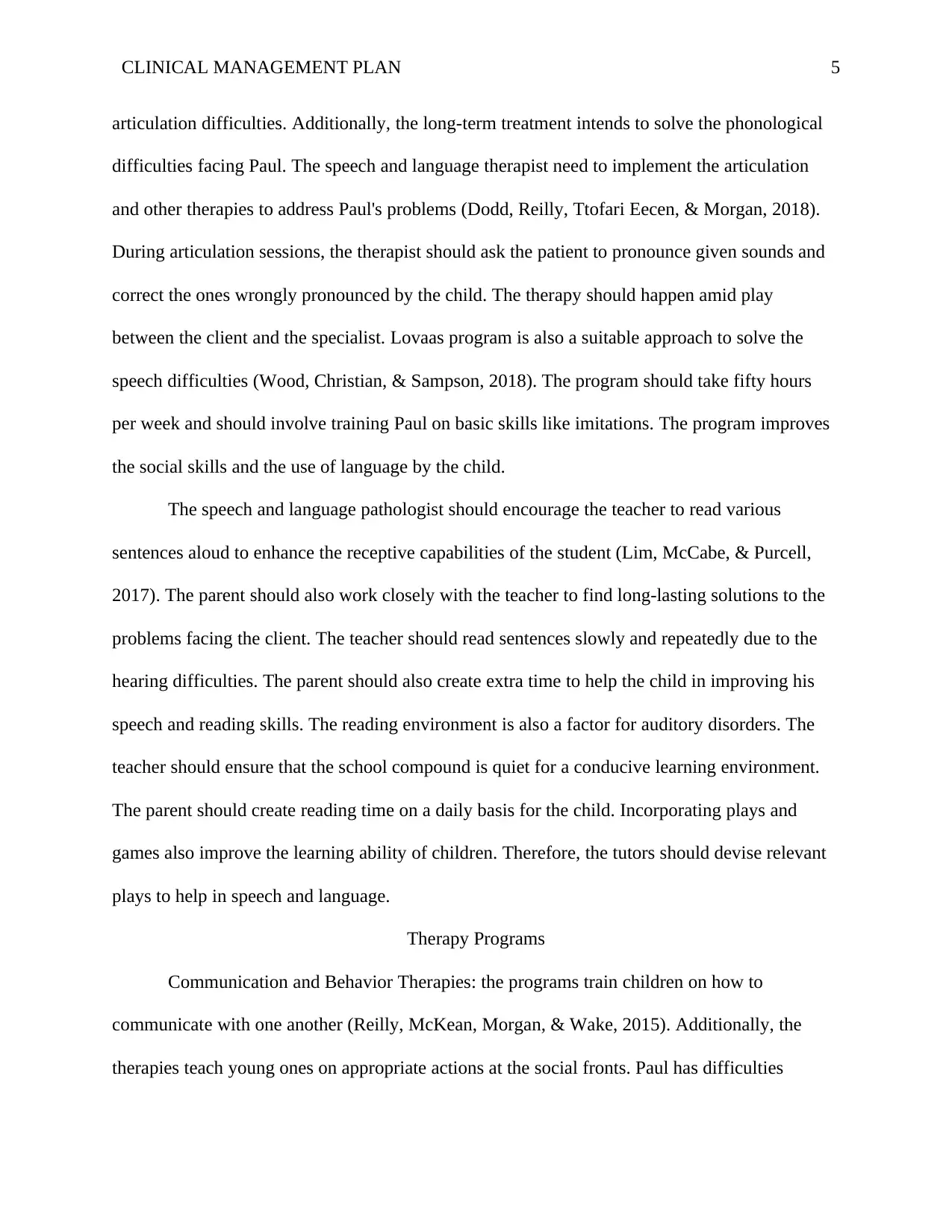
CLINICAL MANAGEMENT PLAN 5
articulation difficulties. Additionally, the long-term treatment intends to solve the phonological
difficulties facing Paul. The speech and language therapist need to implement the articulation
and other therapies to address Paul's problems (Dodd, Reilly, Ttofari Eecen, & Morgan, 2018).
During articulation sessions, the therapist should ask the patient to pronounce given sounds and
correct the ones wrongly pronounced by the child. The therapy should happen amid play
between the client and the specialist. Lovaas program is also a suitable approach to solve the
speech difficulties (Wood, Christian, & Sampson, 2018). The program should take fifty hours
per week and should involve training Paul on basic skills like imitations. The program improves
the social skills and the use of language by the child.
The speech and language pathologist should encourage the teacher to read various
sentences aloud to enhance the receptive capabilities of the student (Lim, McCabe, & Purcell,
2017). The parent should also work closely with the teacher to find long-lasting solutions to the
problems facing the client. The teacher should read sentences slowly and repeatedly due to the
hearing difficulties. The parent should also create extra time to help the child in improving his
speech and reading skills. The reading environment is also a factor for auditory disorders. The
teacher should ensure that the school compound is quiet for a conducive learning environment.
The parent should create reading time on a daily basis for the child. Incorporating plays and
games also improve the learning ability of children. Therefore, the tutors should devise relevant
plays to help in speech and language.
Therapy Programs
Communication and Behavior Therapies: the programs train children on how to
communicate with one another (Reilly, McKean, Morgan, & Wake, 2015). Additionally, the
therapies teach young ones on appropriate actions at the social fronts. Paul has difficulties
articulation difficulties. Additionally, the long-term treatment intends to solve the phonological
difficulties facing Paul. The speech and language therapist need to implement the articulation
and other therapies to address Paul's problems (Dodd, Reilly, Ttofari Eecen, & Morgan, 2018).
During articulation sessions, the therapist should ask the patient to pronounce given sounds and
correct the ones wrongly pronounced by the child. The therapy should happen amid play
between the client and the specialist. Lovaas program is also a suitable approach to solve the
speech difficulties (Wood, Christian, & Sampson, 2018). The program should take fifty hours
per week and should involve training Paul on basic skills like imitations. The program improves
the social skills and the use of language by the child.
The speech and language pathologist should encourage the teacher to read various
sentences aloud to enhance the receptive capabilities of the student (Lim, McCabe, & Purcell,
2017). The parent should also work closely with the teacher to find long-lasting solutions to the
problems facing the client. The teacher should read sentences slowly and repeatedly due to the
hearing difficulties. The parent should also create extra time to help the child in improving his
speech and reading skills. The reading environment is also a factor for auditory disorders. The
teacher should ensure that the school compound is quiet for a conducive learning environment.
The parent should create reading time on a daily basis for the child. Incorporating plays and
games also improve the learning ability of children. Therefore, the tutors should devise relevant
plays to help in speech and language.
Therapy Programs
Communication and Behavior Therapies: the programs train children on how to
communicate with one another (Reilly, McKean, Morgan, & Wake, 2015). Additionally, the
therapies teach young ones on appropriate actions at the social fronts. Paul has difficulties
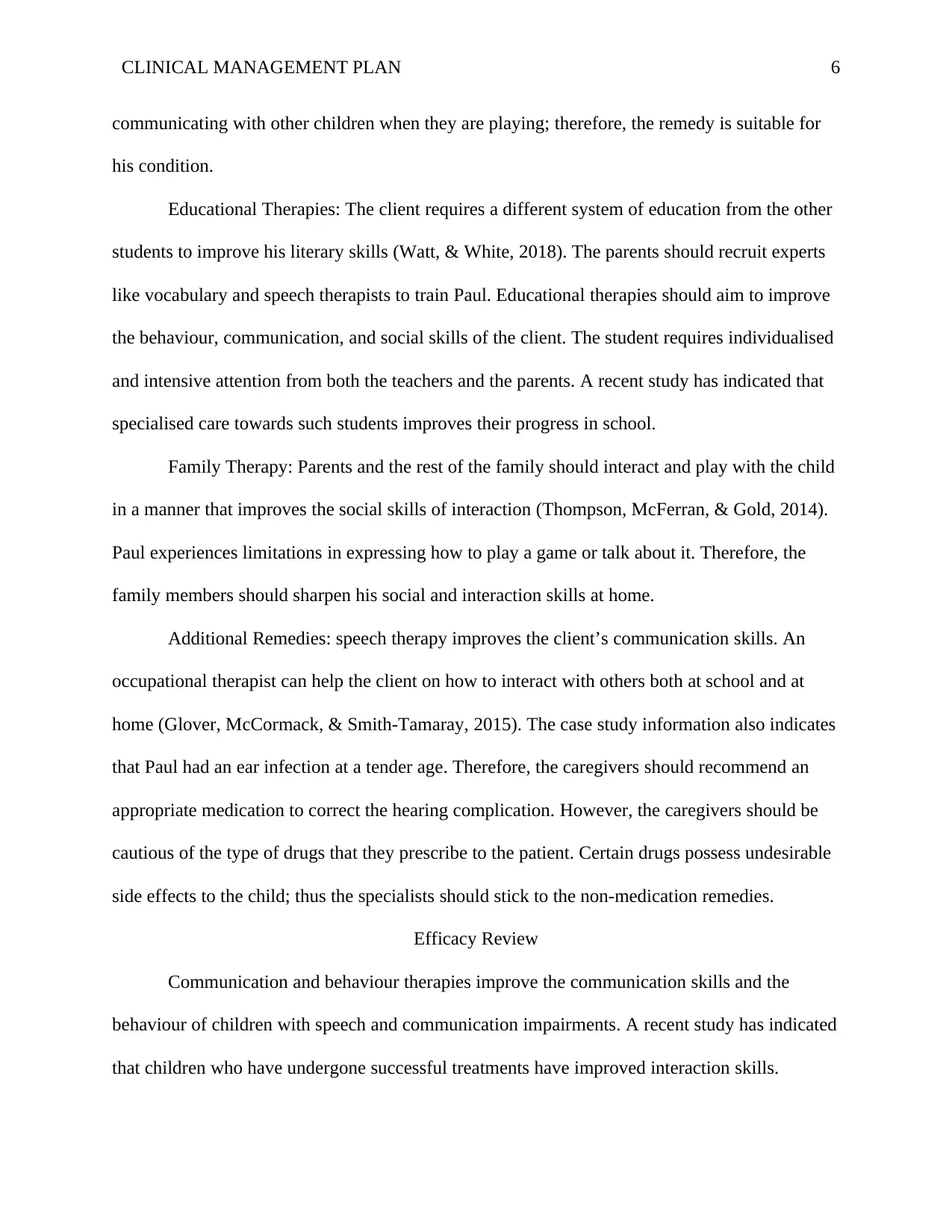
CLINICAL MANAGEMENT PLAN 6
communicating with other children when they are playing; therefore, the remedy is suitable for
his condition.
Educational Therapies: The client requires a different system of education from the other
students to improve his literary skills (Watt, & White, 2018). The parents should recruit experts
like vocabulary and speech therapists to train Paul. Educational therapies should aim to improve
the behaviour, communication, and social skills of the client. The student requires individualised
and intensive attention from both the teachers and the parents. A recent study has indicated that
specialised care towards such students improves their progress in school.
Family Therapy: Parents and the rest of the family should interact and play with the child
in a manner that improves the social skills of interaction (Thompson, McFerran, & Gold, 2014).
Paul experiences limitations in expressing how to play a game or talk about it. Therefore, the
family members should sharpen his social and interaction skills at home.
Additional Remedies: speech therapy improves the client’s communication skills. An
occupational therapist can help the client on how to interact with others both at school and at
home (Glover, McCormack, & Smith-Tamaray, 2015). The case study information also indicates
that Paul had an ear infection at a tender age. Therefore, the caregivers should recommend an
appropriate medication to correct the hearing complication. However, the caregivers should be
cautious of the type of drugs that they prescribe to the patient. Certain drugs possess undesirable
side effects to the child; thus the specialists should stick to the non-medication remedies.
Efficacy Review
Communication and behaviour therapies improve the communication skills and the
behaviour of children with speech and communication impairments. A recent study has indicated
that children who have undergone successful treatments have improved interaction skills.
communicating with other children when they are playing; therefore, the remedy is suitable for
his condition.
Educational Therapies: The client requires a different system of education from the other
students to improve his literary skills (Watt, & White, 2018). The parents should recruit experts
like vocabulary and speech therapists to train Paul. Educational therapies should aim to improve
the behaviour, communication, and social skills of the client. The student requires individualised
and intensive attention from both the teachers and the parents. A recent study has indicated that
specialised care towards such students improves their progress in school.
Family Therapy: Parents and the rest of the family should interact and play with the child
in a manner that improves the social skills of interaction (Thompson, McFerran, & Gold, 2014).
Paul experiences limitations in expressing how to play a game or talk about it. Therefore, the
family members should sharpen his social and interaction skills at home.
Additional Remedies: speech therapy improves the client’s communication skills. An
occupational therapist can help the client on how to interact with others both at school and at
home (Glover, McCormack, & Smith-Tamaray, 2015). The case study information also indicates
that Paul had an ear infection at a tender age. Therefore, the caregivers should recommend an
appropriate medication to correct the hearing complication. However, the caregivers should be
cautious of the type of drugs that they prescribe to the patient. Certain drugs possess undesirable
side effects to the child; thus the specialists should stick to the non-medication remedies.
Efficacy Review
Communication and behaviour therapies improve the communication skills and the
behaviour of children with speech and communication impairments. A recent study has indicated
that children who have undergone successful treatments have improved interaction skills.
⊘ This is a preview!⊘
Do you want full access?
Subscribe today to unlock all pages.

Trusted by 1+ million students worldwide

CLINICAL MANAGEMENT PLAN 7
Behaviour therapies sharpen the behaviour of children; thus improving their interaction with
other children. Educational treatments enhance the performance of students at the literary front
(Voelmle, & Storkel, 2015). The teachers should separate the students with language and
communication difficulties from the rest of the learners. Receiving specialised education
sharpens the skills of the students with complications; hence bringing them at par with their
mates. The therapies require the trainers to read sentences loudly to the student. Additionally, the
teacher should repeat the sentences to enhance reception by the student. A recent investigation
has retaliated that educational therapies sharpen both speech and language skills.
Family therapies also improve the learning capabilities of the student; since the family is
the first teacher (Wallace et al., 2015). Playing and interacting with the child train them on the
appropriate social skills. Therefore, such children excel in interacting with the others both at
school and at home. The family members should train their child in various aspects like
vocabulary amid a game environment. Specialists should educate the family on the appropriate
games to boost the vocabulary and speech of the child. Speech therapists specialise in training
children on practical communication skills (Eadie et al., 2015). Auditory complications at birth
can interfere with the speech of the victims. Therefore, the parent of a child with literary
problems should seek the services of the specialist to sort out the communication difficulties.
Medications are the last line of speech and language remedies due to side effects like dizziness,
nausea, and vomiting.
Measurement and Analysis
Paul has a problem in pronouncing and spelling various vocabularies as mentioned in the
case information and also in the assessment data. To measure the effectiveness of the various
therapies, the teacher should note down a few simple words and ask Paul to pronounce them.
Behaviour therapies sharpen the behaviour of children; thus improving their interaction with
other children. Educational treatments enhance the performance of students at the literary front
(Voelmle, & Storkel, 2015). The teachers should separate the students with language and
communication difficulties from the rest of the learners. Receiving specialised education
sharpens the skills of the students with complications; hence bringing them at par with their
mates. The therapies require the trainers to read sentences loudly to the student. Additionally, the
teacher should repeat the sentences to enhance reception by the student. A recent investigation
has retaliated that educational therapies sharpen both speech and language skills.
Family therapies also improve the learning capabilities of the student; since the family is
the first teacher (Wallace et al., 2015). Playing and interacting with the child train them on the
appropriate social skills. Therefore, such children excel in interacting with the others both at
school and at home. The family members should train their child in various aspects like
vocabulary amid a game environment. Specialists should educate the family on the appropriate
games to boost the vocabulary and speech of the child. Speech therapists specialise in training
children on practical communication skills (Eadie et al., 2015). Auditory complications at birth
can interfere with the speech of the victims. Therefore, the parent of a child with literary
problems should seek the services of the specialist to sort out the communication difficulties.
Medications are the last line of speech and language remedies due to side effects like dizziness,
nausea, and vomiting.
Measurement and Analysis
Paul has a problem in pronouncing and spelling various vocabularies as mentioned in the
case information and also in the assessment data. To measure the effectiveness of the various
therapies, the teacher should note down a few simple words and ask Paul to pronounce them.
Paraphrase This Document
Need a fresh take? Get an instant paraphrase of this document with our AI Paraphraser
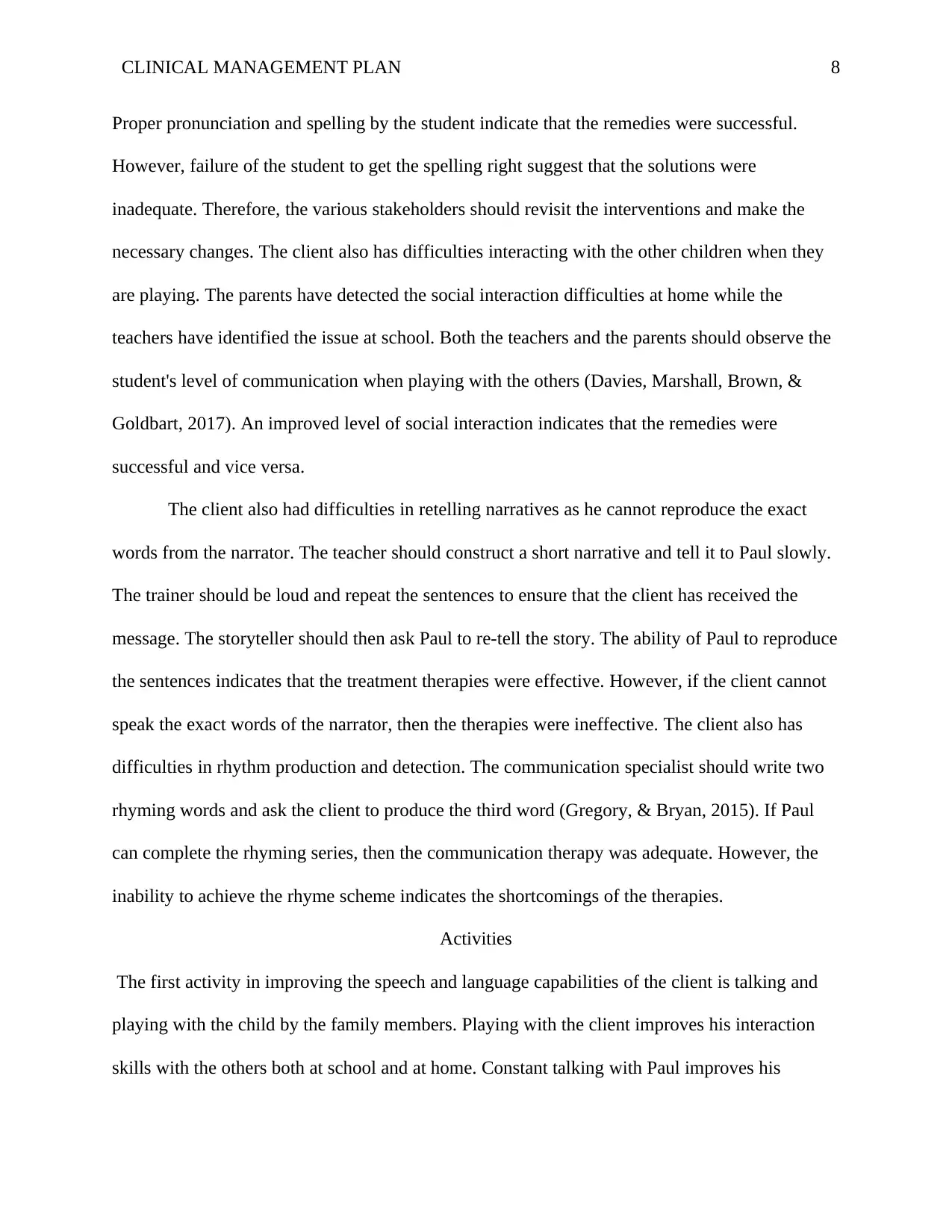
CLINICAL MANAGEMENT PLAN 8
Proper pronunciation and spelling by the student indicate that the remedies were successful.
However, failure of the student to get the spelling right suggest that the solutions were
inadequate. Therefore, the various stakeholders should revisit the interventions and make the
necessary changes. The client also has difficulties interacting with the other children when they
are playing. The parents have detected the social interaction difficulties at home while the
teachers have identified the issue at school. Both the teachers and the parents should observe the
student's level of communication when playing with the others (Davies, Marshall, Brown, &
Goldbart, 2017). An improved level of social interaction indicates that the remedies were
successful and vice versa.
The client also had difficulties in retelling narratives as he cannot reproduce the exact
words from the narrator. The teacher should construct a short narrative and tell it to Paul slowly.
The trainer should be loud and repeat the sentences to ensure that the client has received the
message. The storyteller should then ask Paul to re-tell the story. The ability of Paul to reproduce
the sentences indicates that the treatment therapies were effective. However, if the client cannot
speak the exact words of the narrator, then the therapies were ineffective. The client also has
difficulties in rhythm production and detection. The communication specialist should write two
rhyming words and ask the client to produce the third word (Gregory, & Bryan, 2015). If Paul
can complete the rhyming series, then the communication therapy was adequate. However, the
inability to achieve the rhyme scheme indicates the shortcomings of the therapies.
Activities
The first activity in improving the speech and language capabilities of the client is talking and
playing with the child by the family members. Playing with the client improves his interaction
skills with the others both at school and at home. Constant talking with Paul improves his
Proper pronunciation and spelling by the student indicate that the remedies were successful.
However, failure of the student to get the spelling right suggest that the solutions were
inadequate. Therefore, the various stakeholders should revisit the interventions and make the
necessary changes. The client also has difficulties interacting with the other children when they
are playing. The parents have detected the social interaction difficulties at home while the
teachers have identified the issue at school. Both the teachers and the parents should observe the
student's level of communication when playing with the others (Davies, Marshall, Brown, &
Goldbart, 2017). An improved level of social interaction indicates that the remedies were
successful and vice versa.
The client also had difficulties in retelling narratives as he cannot reproduce the exact
words from the narrator. The teacher should construct a short narrative and tell it to Paul slowly.
The trainer should be loud and repeat the sentences to ensure that the client has received the
message. The storyteller should then ask Paul to re-tell the story. The ability of Paul to reproduce
the sentences indicates that the treatment therapies were effective. However, if the client cannot
speak the exact words of the narrator, then the therapies were ineffective. The client also has
difficulties in rhythm production and detection. The communication specialist should write two
rhyming words and ask the client to produce the third word (Gregory, & Bryan, 2015). If Paul
can complete the rhyming series, then the communication therapy was adequate. However, the
inability to achieve the rhyme scheme indicates the shortcomings of the therapies.
Activities
The first activity in improving the speech and language capabilities of the client is talking and
playing with the child by the family members. Playing with the client improves his interaction
skills with the others both at school and at home. Constant talking with Paul improves his
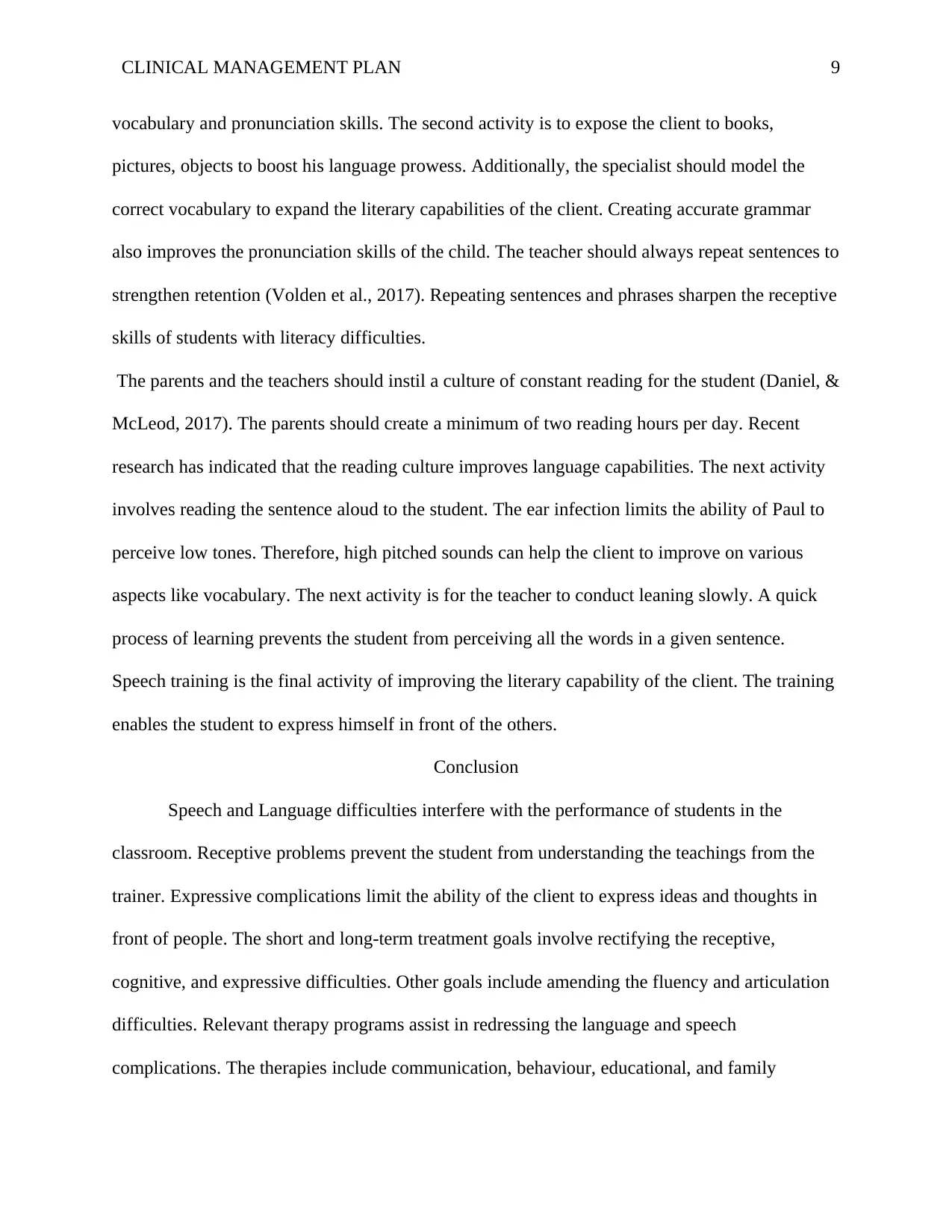
CLINICAL MANAGEMENT PLAN 9
vocabulary and pronunciation skills. The second activity is to expose the client to books,
pictures, objects to boost his language prowess. Additionally, the specialist should model the
correct vocabulary to expand the literary capabilities of the client. Creating accurate grammar
also improves the pronunciation skills of the child. The teacher should always repeat sentences to
strengthen retention (Volden et al., 2017). Repeating sentences and phrases sharpen the receptive
skills of students with literacy difficulties.
The parents and the teachers should instil a culture of constant reading for the student (Daniel, &
McLeod, 2017). The parents should create a minimum of two reading hours per day. Recent
research has indicated that the reading culture improves language capabilities. The next activity
involves reading the sentence aloud to the student. The ear infection limits the ability of Paul to
perceive low tones. Therefore, high pitched sounds can help the client to improve on various
aspects like vocabulary. The next activity is for the teacher to conduct leaning slowly. A quick
process of learning prevents the student from perceiving all the words in a given sentence.
Speech training is the final activity of improving the literary capability of the client. The training
enables the student to express himself in front of the others.
Conclusion
Speech and Language difficulties interfere with the performance of students in the
classroom. Receptive problems prevent the student from understanding the teachings from the
trainer. Expressive complications limit the ability of the client to express ideas and thoughts in
front of people. The short and long-term treatment goals involve rectifying the receptive,
cognitive, and expressive difficulties. Other goals include amending the fluency and articulation
difficulties. Relevant therapy programs assist in redressing the language and speech
complications. The therapies include communication, behaviour, educational, and family
vocabulary and pronunciation skills. The second activity is to expose the client to books,
pictures, objects to boost his language prowess. Additionally, the specialist should model the
correct vocabulary to expand the literary capabilities of the client. Creating accurate grammar
also improves the pronunciation skills of the child. The teacher should always repeat sentences to
strengthen retention (Volden et al., 2017). Repeating sentences and phrases sharpen the receptive
skills of students with literacy difficulties.
The parents and the teachers should instil a culture of constant reading for the student (Daniel, &
McLeod, 2017). The parents should create a minimum of two reading hours per day. Recent
research has indicated that the reading culture improves language capabilities. The next activity
involves reading the sentence aloud to the student. The ear infection limits the ability of Paul to
perceive low tones. Therefore, high pitched sounds can help the client to improve on various
aspects like vocabulary. The next activity is for the teacher to conduct leaning slowly. A quick
process of learning prevents the student from perceiving all the words in a given sentence.
Speech training is the final activity of improving the literary capability of the client. The training
enables the student to express himself in front of the others.
Conclusion
Speech and Language difficulties interfere with the performance of students in the
classroom. Receptive problems prevent the student from understanding the teachings from the
trainer. Expressive complications limit the ability of the client to express ideas and thoughts in
front of people. The short and long-term treatment goals involve rectifying the receptive,
cognitive, and expressive difficulties. Other goals include amending the fluency and articulation
difficulties. Relevant therapy programs assist in redressing the language and speech
complications. The therapies include communication, behaviour, educational, and family
⊘ This is a preview!⊘
Do you want full access?
Subscribe today to unlock all pages.

Trusted by 1+ million students worldwide
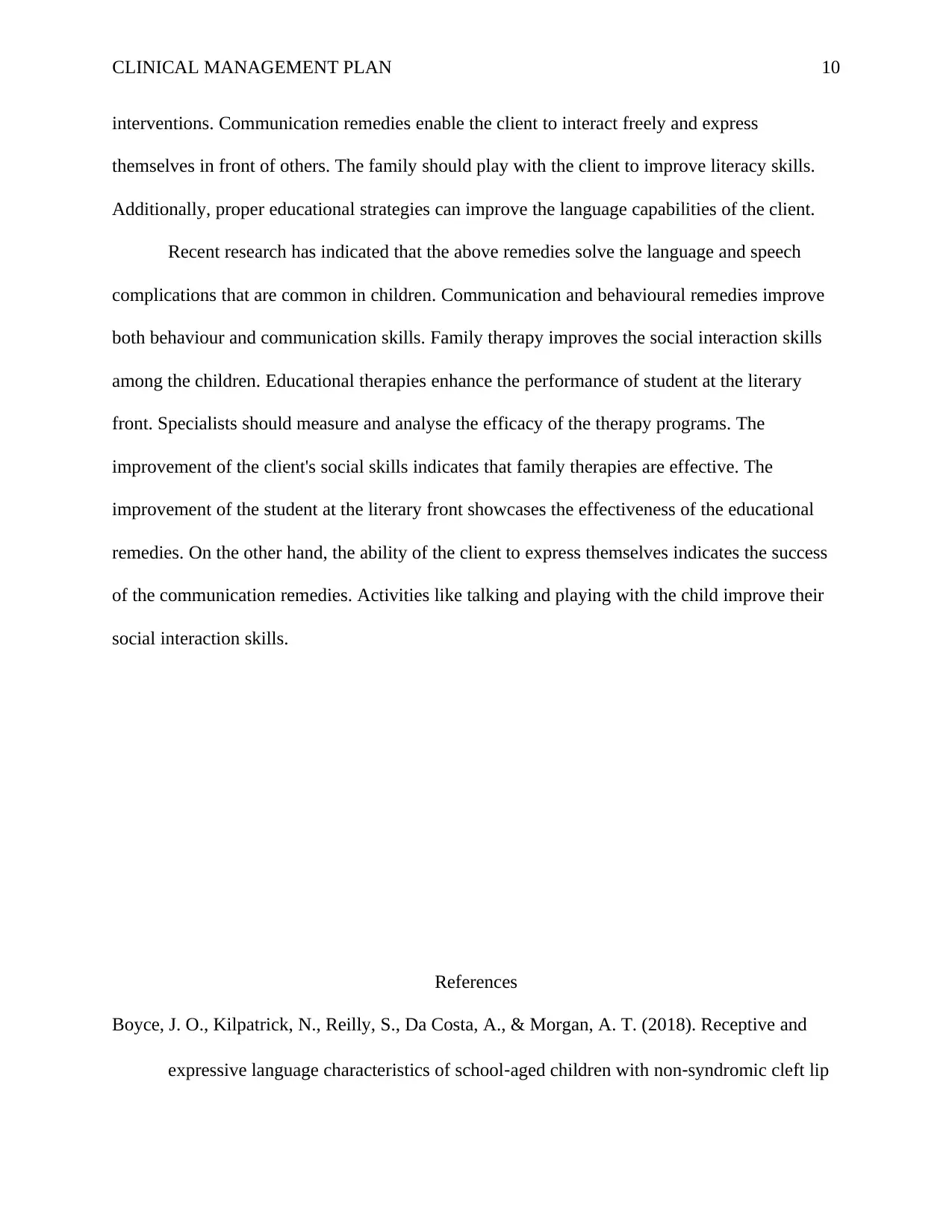
CLINICAL MANAGEMENT PLAN 10
interventions. Communication remedies enable the client to interact freely and express
themselves in front of others. The family should play with the client to improve literacy skills.
Additionally, proper educational strategies can improve the language capabilities of the client.
Recent research has indicated that the above remedies solve the language and speech
complications that are common in children. Communication and behavioural remedies improve
both behaviour and communication skills. Family therapy improves the social interaction skills
among the children. Educational therapies enhance the performance of student at the literary
front. Specialists should measure and analyse the efficacy of the therapy programs. The
improvement of the client's social skills indicates that family therapies are effective. The
improvement of the student at the literary front showcases the effectiveness of the educational
remedies. On the other hand, the ability of the client to express themselves indicates the success
of the communication remedies. Activities like talking and playing with the child improve their
social interaction skills.
References
Boyce, J. O., Kilpatrick, N., Reilly, S., Da Costa, A., & Morgan, A. T. (2018). Receptive and
expressive language characteristics of school‐aged children with non‐syndromic cleft lip
interventions. Communication remedies enable the client to interact freely and express
themselves in front of others. The family should play with the client to improve literacy skills.
Additionally, proper educational strategies can improve the language capabilities of the client.
Recent research has indicated that the above remedies solve the language and speech
complications that are common in children. Communication and behavioural remedies improve
both behaviour and communication skills. Family therapy improves the social interaction skills
among the children. Educational therapies enhance the performance of student at the literary
front. Specialists should measure and analyse the efficacy of the therapy programs. The
improvement of the client's social skills indicates that family therapies are effective. The
improvement of the student at the literary front showcases the effectiveness of the educational
remedies. On the other hand, the ability of the client to express themselves indicates the success
of the communication remedies. Activities like talking and playing with the child improve their
social interaction skills.
References
Boyce, J. O., Kilpatrick, N., Reilly, S., Da Costa, A., & Morgan, A. T. (2018). Receptive and
expressive language characteristics of school‐aged children with non‐syndromic cleft lip
Paraphrase This Document
Need a fresh take? Get an instant paraphrase of this document with our AI Paraphraser
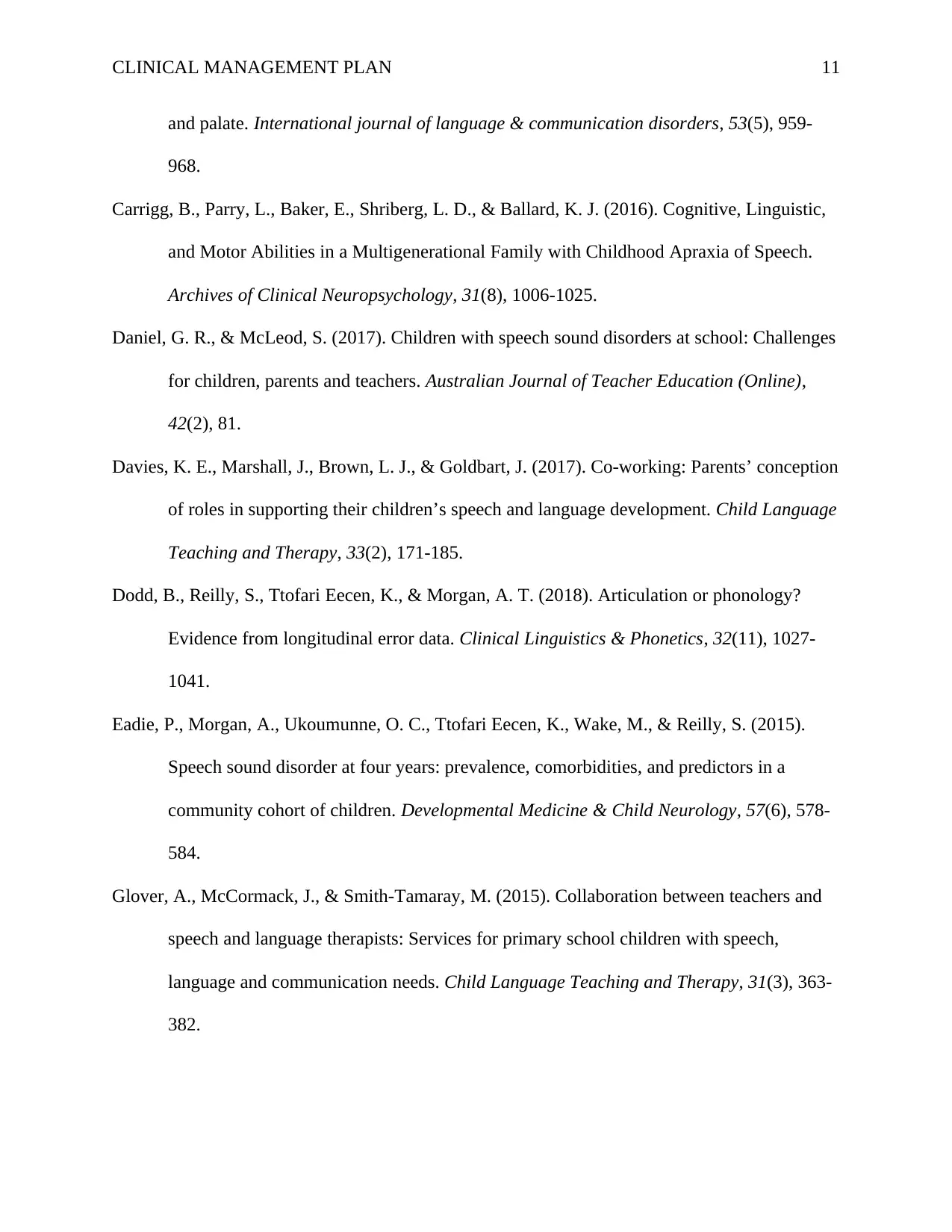
CLINICAL MANAGEMENT PLAN 11
and palate. International journal of language & communication disorders, 53(5), 959-
968.
Carrigg, B., Parry, L., Baker, E., Shriberg, L. D., & Ballard, K. J. (2016). Cognitive, Linguistic,
and Motor Abilities in a Multigenerational Family with Childhood Apraxia of Speech.
Archives of Clinical Neuropsychology, 31(8), 1006-1025.
Daniel, G. R., & McLeod, S. (2017). Children with speech sound disorders at school: Challenges
for children, parents and teachers. Australian Journal of Teacher Education (Online),
42(2), 81.
Davies, K. E., Marshall, J., Brown, L. J., & Goldbart, J. (2017). Co-working: Parents’ conception
of roles in supporting their children’s speech and language development. Child Language
Teaching and Therapy, 33(2), 171-185.
Dodd, B., Reilly, S., Ttofari Eecen, K., & Morgan, A. T. (2018). Articulation or phonology?
Evidence from longitudinal error data. Clinical Linguistics & Phonetics, 32(11), 1027-
1041.
Eadie, P., Morgan, A., Ukoumunne, O. C., Ttofari Eecen, K., Wake, M., & Reilly, S. (2015).
Speech sound disorder at four years: prevalence, comorbidities, and predictors in a
community cohort of children. Developmental Medicine & Child Neurology, 57(6), 578-
584.
Glover, A., McCormack, J., & Smith-Tamaray, M. (2015). Collaboration between teachers and
speech and language therapists: Services for primary school children with speech,
language and communication needs. Child Language Teaching and Therapy, 31(3), 363-
382.
and palate. International journal of language & communication disorders, 53(5), 959-
968.
Carrigg, B., Parry, L., Baker, E., Shriberg, L. D., & Ballard, K. J. (2016). Cognitive, Linguistic,
and Motor Abilities in a Multigenerational Family with Childhood Apraxia of Speech.
Archives of Clinical Neuropsychology, 31(8), 1006-1025.
Daniel, G. R., & McLeod, S. (2017). Children with speech sound disorders at school: Challenges
for children, parents and teachers. Australian Journal of Teacher Education (Online),
42(2), 81.
Davies, K. E., Marshall, J., Brown, L. J., & Goldbart, J. (2017). Co-working: Parents’ conception
of roles in supporting their children’s speech and language development. Child Language
Teaching and Therapy, 33(2), 171-185.
Dodd, B., Reilly, S., Ttofari Eecen, K., & Morgan, A. T. (2018). Articulation or phonology?
Evidence from longitudinal error data. Clinical Linguistics & Phonetics, 32(11), 1027-
1041.
Eadie, P., Morgan, A., Ukoumunne, O. C., Ttofari Eecen, K., Wake, M., & Reilly, S. (2015).
Speech sound disorder at four years: prevalence, comorbidities, and predictors in a
community cohort of children. Developmental Medicine & Child Neurology, 57(6), 578-
584.
Glover, A., McCormack, J., & Smith-Tamaray, M. (2015). Collaboration between teachers and
speech and language therapists: Services for primary school children with speech,
language and communication needs. Child Language Teaching and Therapy, 31(3), 363-
382.
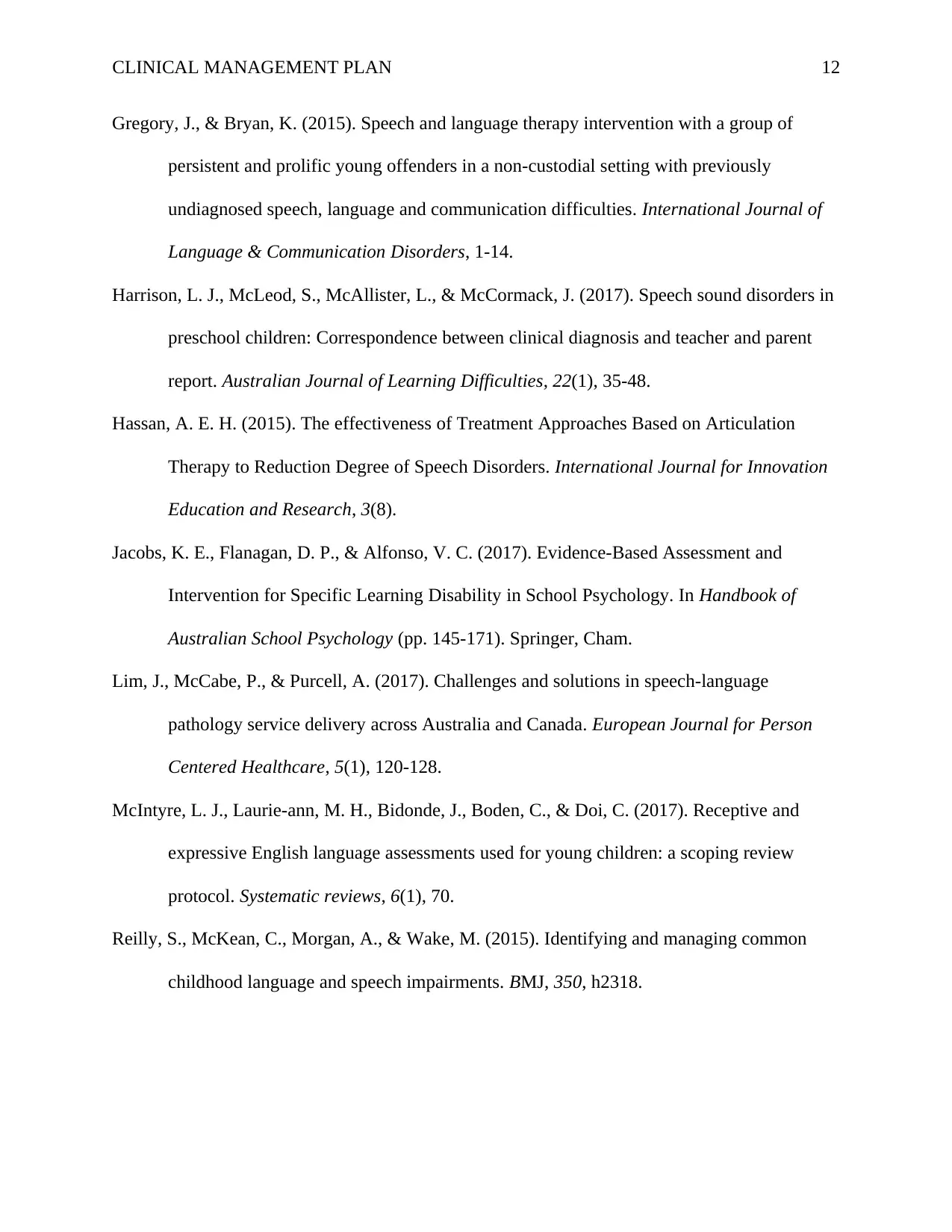
CLINICAL MANAGEMENT PLAN 12
Gregory, J., & Bryan, K. (2015). Speech and language therapy intervention with a group of
persistent and prolific young offenders in a non-custodial setting with previously
undiagnosed speech, language and communication difficulties. International Journal of
Language & Communication Disorders, 1-14.
Harrison, L. J., McLeod, S., McAllister, L., & McCormack, J. (2017). Speech sound disorders in
preschool children: Correspondence between clinical diagnosis and teacher and parent
report. Australian Journal of Learning Difficulties, 22(1), 35-48.
Hassan, A. E. H. (2015). The effectiveness of Treatment Approaches Based on Articulation
Therapy to Reduction Degree of Speech Disorders. International Journal for Innovation
Education and Research, 3(8).
Jacobs, K. E., Flanagan, D. P., & Alfonso, V. C. (2017). Evidence-Based Assessment and
Intervention for Specific Learning Disability in School Psychology. In Handbook of
Australian School Psychology (pp. 145-171). Springer, Cham.
Lim, J., McCabe, P., & Purcell, A. (2017). Challenges and solutions in speech-language
pathology service delivery across Australia and Canada. European Journal for Person
Centered Healthcare, 5(1), 120-128.
McIntyre, L. J., Laurie-ann, M. H., Bidonde, J., Boden, C., & Doi, C. (2017). Receptive and
expressive English language assessments used for young children: a scoping review
protocol. Systematic reviews, 6(1), 70.
Reilly, S., McKean, C., Morgan, A., & Wake, M. (2015). Identifying and managing common
childhood language and speech impairments. BMJ, 350, h2318.
Gregory, J., & Bryan, K. (2015). Speech and language therapy intervention with a group of
persistent and prolific young offenders in a non-custodial setting with previously
undiagnosed speech, language and communication difficulties. International Journal of
Language & Communication Disorders, 1-14.
Harrison, L. J., McLeod, S., McAllister, L., & McCormack, J. (2017). Speech sound disorders in
preschool children: Correspondence between clinical diagnosis and teacher and parent
report. Australian Journal of Learning Difficulties, 22(1), 35-48.
Hassan, A. E. H. (2015). The effectiveness of Treatment Approaches Based on Articulation
Therapy to Reduction Degree of Speech Disorders. International Journal for Innovation
Education and Research, 3(8).
Jacobs, K. E., Flanagan, D. P., & Alfonso, V. C. (2017). Evidence-Based Assessment and
Intervention for Specific Learning Disability in School Psychology. In Handbook of
Australian School Psychology (pp. 145-171). Springer, Cham.
Lim, J., McCabe, P., & Purcell, A. (2017). Challenges and solutions in speech-language
pathology service delivery across Australia and Canada. European Journal for Person
Centered Healthcare, 5(1), 120-128.
McIntyre, L. J., Laurie-ann, M. H., Bidonde, J., Boden, C., & Doi, C. (2017). Receptive and
expressive English language assessments used for young children: a scoping review
protocol. Systematic reviews, 6(1), 70.
Reilly, S., McKean, C., Morgan, A., & Wake, M. (2015). Identifying and managing common
childhood language and speech impairments. BMJ, 350, h2318.
⊘ This is a preview!⊘
Do you want full access?
Subscribe today to unlock all pages.

Trusted by 1+ million students worldwide
1 out of 13
Your All-in-One AI-Powered Toolkit for Academic Success.
+13062052269
info@desklib.com
Available 24*7 on WhatsApp / Email
![[object Object]](/_next/static/media/star-bottom.7253800d.svg)
Unlock your academic potential
Copyright © 2020–2025 A2Z Services. All Rights Reserved. Developed and managed by ZUCOL.


